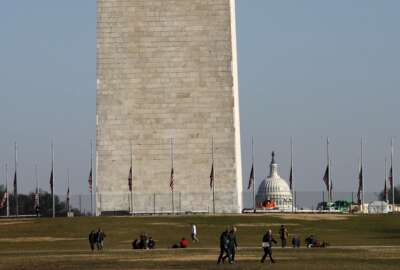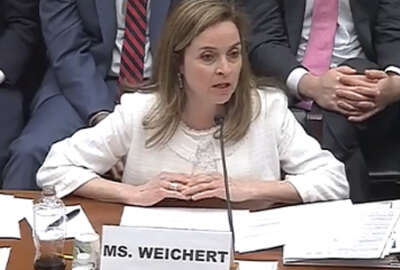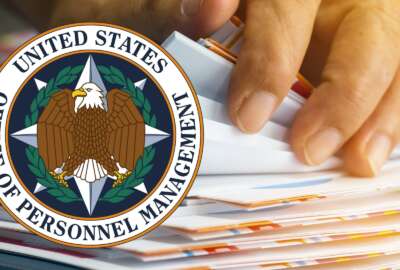

The Office of Personnel Management has new guidance for federal employees after the longest government shutdown in history has ended.
Best listening experience is on Chrome, Firefox or Safari. Subscribe to Federal Drive’s daily audio interviews on Apple Podcasts or PodcastOne.
Updated on Tuesday, Jan. 29, 2019 at 9:00 a.m. to reflect additional information from the General Services Administration.
The federal workforce will attempt to regain some sense of normalcy as employees head back to work after the longest government shutdown in U.S. history.
But the 35-day government shutdown was not normal, by any stretch of the imagination, as the Office of Personnel Management acknowledged in recent guidance issued Sunday.
Agencies should be as flexible as possible as employees return to work, acting OPM Director Margaret Weichert wrote in the new memo.
“Due to the length of the lapse, we anticipate that some employees may face extenuating circumstances or personal challenges that impact their ability to return to work on their next workday immediately following the end of the lapse,” Weichert wrote. “Accordingly, we encourage managers to take these individual challenges into consideration, and to the extent possible, provide appropriate flexibility to employees who are facing legitimate difficulties that may delay their return to work.”





The Government Employee Fair Treatment Act, which President Donald Trump signed into law earlier in January, specifies federal employees get paid as soon as possible after a government shutdown ends, regardless of the next scheduled pay period.
The National Finance Center has said employees should receive their paychecks no later than Jan. 31.
The National Finance Center handles payroll for Coast Guard civilian employees. According to a message from Coast Guard leadership, civilian employees paid through NFC will receive a single lump sum for pay period 26, Dec. 23 through Jan. 5, and pay period 1, Jan. 6 through Jan. 19.
Deductions will be taken out for each pay period, but employees will receive one leave and earning statement, according to the Coast Guard.
Coast Guard staff worked through the weekend to finalize and check employees’ timecards.
The Coast Guard on Friday initially estimated it would deliver paychecks to its military members within three-to-five business days of the end of the government shutdown. Some military members may receive back pay sooner, however, as the service secured after-hours support with the U.S. Treasury to process checks as soon as possible.
“Once Treasury transmits funds to the private banking system, the hours and policies of each individual bank will dictate when you will see your pay,” Coast Guard Vice Commandant Adm. Charles Ray said Sunday in a message to the workforce. “We expect that members should see their mid-month pay as early as Tuesday, but no later than Wednesday, Jan. 30. Pay for Jan. 31 is expected to be processed on time.”
The military is on a different payroll schedule than most federal civilian employees. Coast Guard military missed one paycheck on or around Jan. 15. The next military pay period is scheduled for Jan. 31.
Coast Guard military retirees should receive their normally scheduled Feb. 1 annuitant benefits by Jan. 31, Ray added. Because the Coast Guard uses a “pay-as-you-go” appropriation to disburse retirement payments for its military retirees, the service said its February annuity payments were in jeopardy if the government shutdown had continued through January.
The Interior Business Center, which counts pay periods differently than the other major providers, said its clients will receive pay for two missed pay periods no later than Jan. 31.Depending on the employees’ financial institution and direct deposit time frames, payments may arrive before Jan. 31.
IBC will issue back pay for pay period 1, Dec. 23, 2018 through Jan. 5, 2019, and pay period 2, Jan. 6 through Jan. 19, in two separate payments.
“Back pay will be paid in calendar year/tax year 2019 and will be included in employees’ 2019 taxable wages,” a spokeswoman for the Interior Business Center told Federal News Network.
The General Services Administration Payroll Services branch said employees can expect their paychecks by Jan. 31. Employees will receive one payment that covers both missed pay periods, from Dec. 22 through Jan. 19, a GSA spokeswoman told Federal Network.
Back pay that covered Dec. 22-31 will be included on 2019 W-2s, the spokeswoman said.
Meanwhile, a group of 28 senators, including Maryland Sens. Chris Van Hollen and Ben Cardin, Lisa Murkowski (R-Alaska), Susan Collins (R-Maine) and Virginia Sens. Tim Kaine and Mark Warner, are also looking for more details about the timing of federal employee back pay.
“This government shutdown made it clearer than ever just how dedicated civil servants are to their jobs and how vital those jobs are to the nation,” the senators wrote Monday in a letter to OPM. “We ask that you publicize when exactly these civil servants can expect to receive their back pay, and we hope it will arrive very soon.”
Weichert responded to the senators’ inquiry with her own Tweet, confirming the goal that many federal payroll providers had described to issue back pay by the end of this week.
Federal employees across the affected agencies worked all weekend to ensure that Fed colleagues receive their pay as quickly as possible. This activity to run an unprecedented mid-cycle payroll is designed to get everyone paid before month end
— Margaret Weichert (@Weichert45) January 28, 2019
Excepted employees will paid their “standard rate of pay” for the hours they worked during the government shutdown, including any overtime.
Furloughed employees will be paid their “standard rate of pay” for the hours they would have worked if the government shutdown hadn’t occurred, OPM said.
If a furloughed employee had been scheduled to work overtime, for example, during the government shutdown but couldn’t due to the lapse, his or her retroactive pay should also reflect overtime, night or other premium pay as if the work had been performed, OPM said.
In addition, allowances, differentials and other payments such as administratively uncontrollable overtime pay or law enforcement availability pay will also be paid as if the furloughed employee had been at work.
Payroll providers may make some “simplifying assumptions” in order to issue retroactive pay as quickly as possible, according to OPM. In many cases, agencies aren’t following their typical time calculation process, so federal employees may see a mistake on their leave and earnings statements. To move checks out as a quickly as possible, most agencies will correct timecards after the fact.
“For example, the initial retroactive pay may not include pay for irregular overtime work performed by excepted employees during the lapse in appropriations,” Weichert said. “Payroll providers will work with agencies to make any necessary adjustments as soon as practicable.”
While most employees impacted by the government shutdown will get paid for any furlough hours, there are a few exceptions.
Furloughed employees aren’t entitled to back pay if they had previously scheduled to be in non-pay status for any reason. Employees who had scheduled to take “leave without pay,” for example, during the furlough, won’t be paid for those hours.
In addition, excepted employees who failed to show up for work, didn’t communicate those plans with their supervisors and were considered “absent without leave” (AWOL) for any period of time during the government shutdown won’t be paid for that time not at work, OPM said.
Excepted employees who requested and were authorized to use paid leave during the government shutdown will be paid and charged for the time under normal leave rules, according to OPM.
Excepted employees who opted to take leave during the government shutdown in “default furlough status” will technically receive retroactive pay, as OPM has previously noted.
Agencies will also begin to adjust furloughed employees’ leave banks after the shutdown. Even though furloughed employees weren’t in pay status during the lapse in appropriations, those employees will now be considered back in “pay status” for the time they would have spent working during the government shutdown.
“Agencies must adjust the employee’s leave account for proper re-credit of any lost accrual of annual or sick leave due to being in a non pay status,” OPM said. “Since the employee is retroactively placed in a pay status, annual and sick leave will accrue in accordance with the normal rules.”
Excepted employees should work with their agencies to make sure the leave they accrued while working during the government shutdown has been properly documented.
OPM earlier in January determined agencies should restore use-or-lose leave that employees had scheduled to take at the end of 2018 but couldn’t due to the partial government shutdown — only if employees requested to take that leave before Nov. 24, 2018.
Specifically, this applies to any leave that impacted employees wanted to take before Jan. 5. Agencies will restore this leave, as long as employees met the Nov. 24 deadline, OPM said Sunday.
Some federal employees told Federal News Network they had waited until after the Nov. 24 deadline to see if the President might declare Dec. 24 a federal holiday.
OPM has now weighed in on this issue.
For employees who didn’t meet the Nov. 24 scheduling requirement to take leave on Dec. 24, agencies can’t restore leave for that day.
“For an employees who did meet the advanced scheduling requirement for leave scheduled on Dec. 24, the establishment of a holiday by the President does not constitute an exigency of the public business,” OPM wrote. “Thus, annual leave forfeited because the Dec. 24 holiday prevented its use cannot be restored just because the holiday prevented usage of the leave.”
For employees who wanted to reschedule previously approved leave for Dec. 24 to another day in 2018 but couldn’t because of the government shutdown, agencies may restore leave for that day, OPM said.
Employees who were scheduled to use leave without pay or take time under the Family and Medical Leave Act (FMLA) can find more information from OPM here.
No, not during the actual government shutdown.
Agencies will need to make retirement deductions from an employee’s retroactive basic pay for the length of the shutdown, from Dec. 22, 2018 through Jan. 25, 2019, OPM said. Agencies will also need to contribute their corresponding share for the employee’s retroactive payment.
Total retirement deductions and contributions should equal the amount that would have been withheld if the government hadn’t shut down, OPM said.
For the purposes of calculating an employee’s retirement-creditable service, the government shutdown won’t have an impact.
Agencies should make an employee’s retirement effective on the date in which an employee had indicated his or her intention to retire, according to OPM.
“The retirement request may be informal (such as a letter requesting retirement and can be either mailed or personally submitted to the agency (even if put under the door),” OPM’s memo reads. “Any additional required paperwork, such as the formal retirement application form, may be completed after the date of enactment. No time periods after the effective date of the retirement may be considered as duty time, since the individual would no longer be an employee of the agency.”
Agencies should quickly process retirement applications that have been delayed because of the government shutdown and submitted to OPM.
According to guidance from the 1978 comptroller general, some employees can request retirement retroactive to the date previously requested, according to OPM. It’s up to each employing agency to make sure a specific employee has met these requirements before approving retroactive retirement.
Agencies may give eligible employees more time to enroll or change their enrollment in the Federal Employees Health Benefits Program (FEHBP) due to a qualifying life event that occurred during the government shutdown, OPM said.
“In cases where the effective date would normally be the first day of the first pay period following the day the employing office receives the enrollment request and that follows a pay period during any part of which the employee is in pay status, agencies may assign the effective date as if the employee had submitted the enrollment request immediately following the event,” the memo reads.
Agencies can also use their belated enrollment authority to extend the time that an employee would otherwise have to request or change enrollment, OPM said.
Agencies should adjust federal employees’ retroactive pay to reflect typical deductions and government contributions toward FEHBP. Standard deductions and contributions would apply as if the government shutdown hadn’t occurred.
BENEFEDS and Long Term Care Partners, which administer the Federal Employees Dental and Vision Insurance Program (FEDVIP) and Federal Long Term Care Insurance Program, respectively, will instruct agencies how to process deductions for enrollees after the government shutdown.
Agencies generally shouldn’t take deductions for missed FEDVIP, long term care or Federal Flexible Spening Account Program payments or allotments from retroactive pay. Instead, those deductions will come from future payments, which BENEFEDS and Long Term Care Partners will calculate, according to OPM.
Participants in the FEDVIP, long term care or FSAFEDS programs shouldn’t have received direct bills for missed premiums during the government shutdown.
In addition, agencies should take standard deductions and make usual contributions for employees enrolled in the Federal Employees’ Group Life Insurance Program (FEGLI). Agencies should apply those deductions to an employee’s retroactive pay.
Most likely.
Agencies must inform state offices if an unemployment beneficiary has received recent retroactive pay within the past 52 weeks, according to OPM.
If so, it’s up to each state to determine whether a federal employee and unemployment beneficiary needs to repay benefits and how that process will begin.
Copyright © 2025 Federal News Network. All rights reserved. This website is not intended for users located within the European Economic Area.
Nicole Ogrysko is a reporter for Federal News Network focusing on the federal workforce and federal pay and benefits.
Follow @nogryskoWFED
